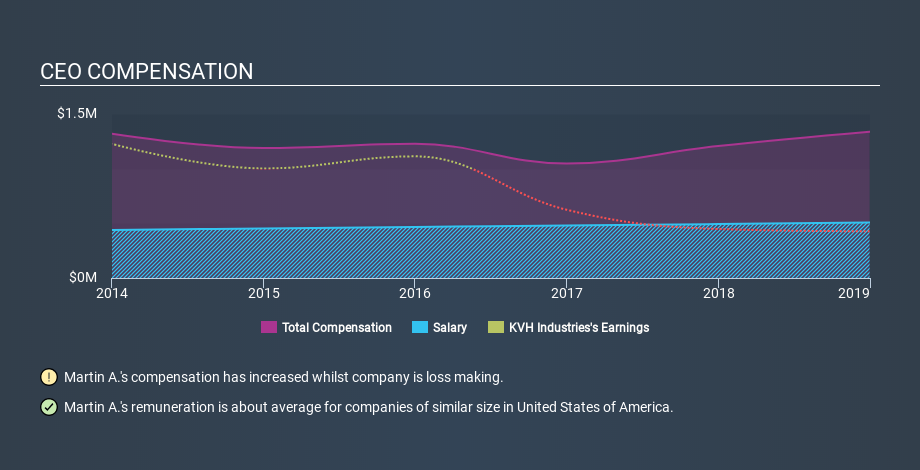How Should Investors Feel About KVH Industries, Inc.'s (NASDAQ:KVHI) CEO Pay?

Martin A. Van Heyningen became the CEO of KVH Industries, Inc. (NASDAQ:KVHI) in 1990. This analysis aims first to contrast CEO compensation with other companies that have similar market capitalization. Then we'll look at a snap shot of the business growth. Third, we'll reflect on the total return to shareholders over three years, as a second measure of business performance. This method should give us information to assess how appropriately the company pays the CEO.
See our latest analysis for KVH Industries
How Does Martin A. Van Heyningen's Compensation Compare With Similar Sized Companies?
Our data indicates that KVH Industries, Inc. is worth US$162m, and total annual CEO compensation was reported as US$1.3m for the year to December 2018. While we always look at total compensation first, we note that the salary component is less, at US$508k. Importantly, there may be performance hurdles relating to the non-salary component of the total compensation. We looked at a group of companies with market capitalizations from US$100m to US$400m, and the median CEO total compensation was US$1.5m.
Now let's take a look at the pay mix on an industry and company level to gain a better understanding of where KVH Industries stands. On a sector level, around 31% of total compensation represents salary and 69% is other remuneration. So it seems like there isn't a significant difference between KVH Industries and the broader market, in terms of salary allocation in the overall compensation package.
That means Martin A. Van Heyningen receives fairly typical remuneration for the CEO of a company that size. While this data point isn't particularly informative alone, it gains more meaning when considered with business performance. The graphic below shows how CEO compensation at KVH Industries has changed from year to year.
Is KVH Industries, Inc. Growing?
On average over the last three years, KVH Industries, Inc. has shrunk earnings per share by 6.3% each year (measured with a line of best fit). It achieved revenue growth of 3.2% over the last year.
Few shareholders would be pleased to read that earnings per share are lower over three years. The modest increase in revenue in the last year isn't enough to make me overlook the disappointing change in earnings per share. These factors suggest that the business performance wouldn't really justify a high pay packet for the CEO. Shareholders might be interested in this free visualization of analyst forecasts.
Has KVH Industries, Inc. Been A Good Investment?
KVH Industries, Inc. has generated a total shareholder return of 7.1% over three years, so most shareholders wouldn't be too disappointed. But they probably don't want to see the CEO paid more than is normal for companies around the same size.
In Summary...
Remuneration for Martin A. Van Heyningen is close enough to the median pay for a CEO of a similar sized company .
We're not seeing great strides in earnings per share, and total returns were decent but not amazing in the last three years. We're not saying the CEO pay is too generous, but one might argue that the company should improve returns to shareholders before increasing it. Moving away from CEO compensation for the moment, we've identified 3 warning signs for KVH Industries that you should be aware of before investing.
Important note: KVH Industries may not be the best stock to buy. You might find something better in this list of interesting companies with high ROE and low debt.
If you spot an error that warrants correction, please contact the editor at editorial-team@simplywallst.com. This article by Simply Wall St is general in nature. It does not constitute a recommendation to buy or sell any stock, and does not take account of your objectives, or your financial situation. Simply Wall St has no position in the stocks mentioned.
We aim to bring you long-term focused research analysis driven by fundamental data. Note that our analysis may not factor in the latest price-sensitive company announcements or qualitative material. Thank you for reading.

 Yahoo News
Yahoo News 

